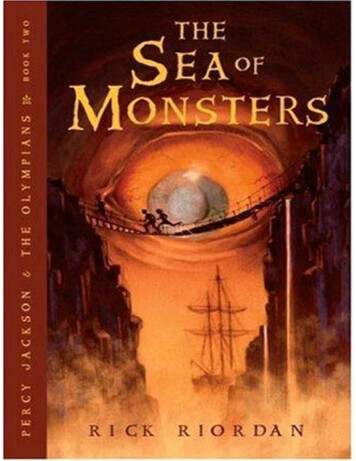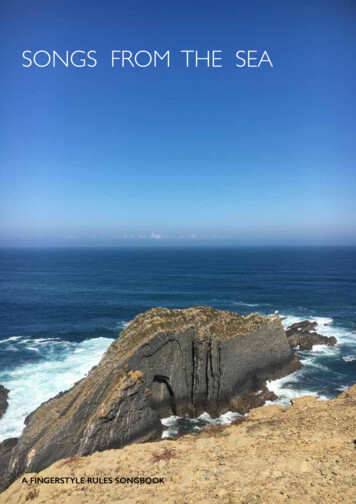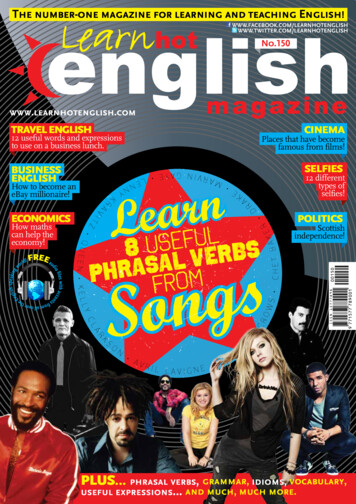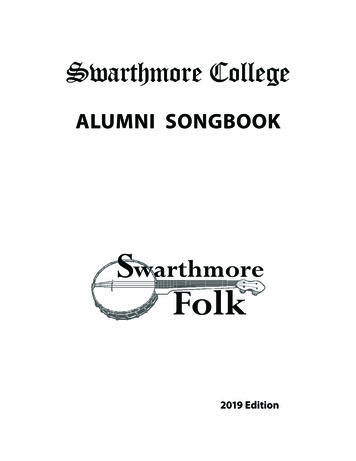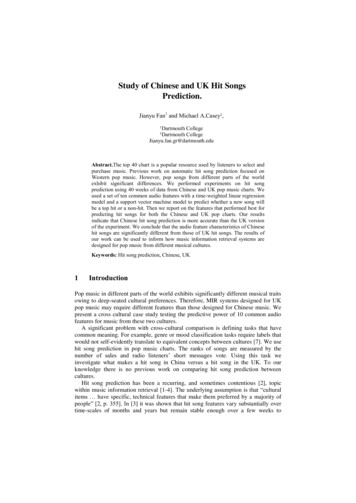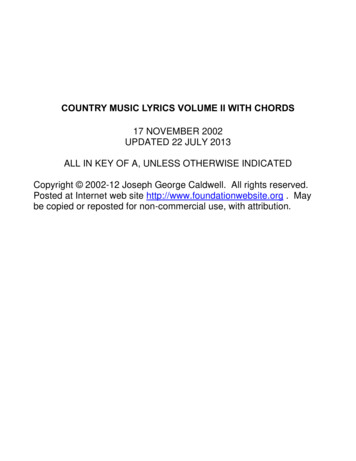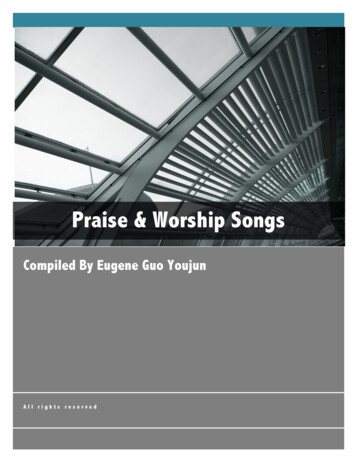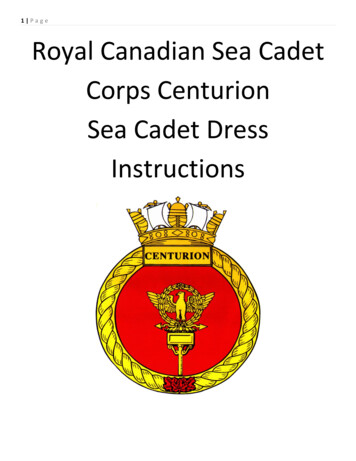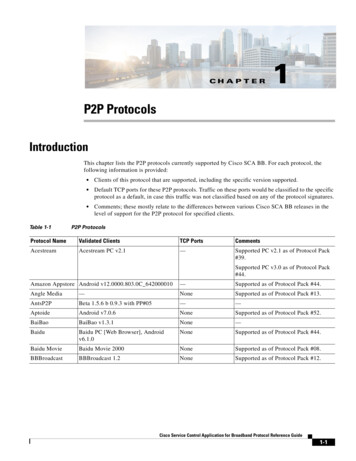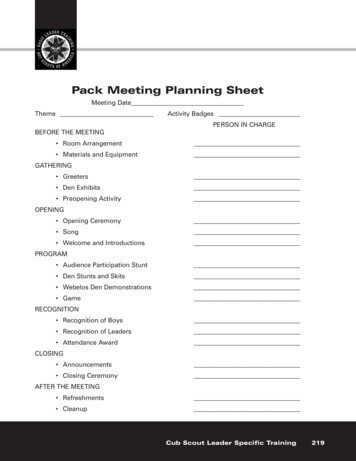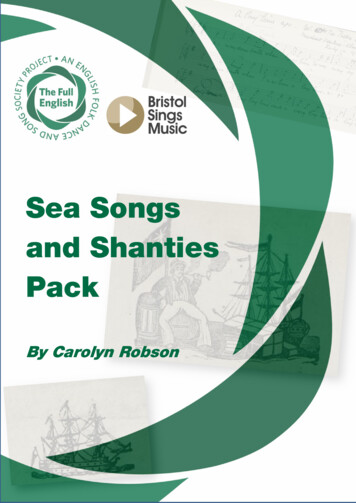
Transcription
Sea Songsand ShantiesPackBy Carolyn Robson
Unlocking hidden treasures ofEngland’s cultural heritageExplore Discover Take PartThe Full EnglishThe Full English is a unique nationwide project unlocking hidden treasures of England’scultural heritage by making over 58,000 original source documents from 12 major folkcollectors available to the world via a ground-breaking nationwide digital archive andlearning project. The project is led by the English Folk Dance and Song Society (EFDSS),funded by the Heritage Lottery Fund, and in partnership with Bristol Plays Music andother cultural partners across England.The Full English digital archive has thousands of traditional folk songs that were collectedfrom across the country. Some of these songs are known widely, others have laindormant in notebooks and files within archives for decades. This Bristol Folk Song packgives schools across Bristol the chance to bring them back to life and give them a newvoice in the 21st century! Supported by the National Lottery through the HeritageLottery Fund, the National Folk Music Fund and The Folklore Society.Bristol Sings MusicBristol Sings Music is the singing strategy for Bristol Plays Music. It aims to enable allchildren and young people in our schools to access opportunities to sing, and todevelop their skills, knowledge and repertoire to maintain provision in the coming years.Led by Welsh National Opera, Bristol Sings Music also involves Bristol Plays Music, StGeorge’s Bristol, Sing Up, South West Music School, Drake Music, Making Music, BristolChoral Society and Bristol Schools' Music Society. The Partnership is passionate aboutsinging in Bristol, bringing together good practice and join up the singing sector.Leading on the project for Welsh National Opera is project manager LaurieStewart. Laurie has working in the field of music education for many years and wasformally Sing Up Area Leader for Bristol. She is also a classically trained singer, studyingat the Royal College of Music (BMus Hons) and The Royal Welsh College of Music andDrama (MMus).www.efdss.org2
Unlocking hidden treasures ofEngland’s cultural heritageExplore Discover Take PartWarm UpWarm up with the song My Bonnie Lies Over the Ocean; learn the song then playthis game:(i) Sitting on chairs in a circle stand or sit on all the words beginning with theletter ‘b’ (starts and ends sitting.)(ii) Next while sitting down in a circle, clap on all the words that contain an ‘o’.(iii) Finally stand or sit on words beginning with ‘b’ and clap on words containingan ‘o’ at the same time.My Bonnie lies over the oceanMy Bonnie lies over the seaMy Bonnie lies over the oceanO bring back my Bonnie to meBring back, bring backO bring back my Bonnie to me, to meBring back, bring backO bring back my Bonnie to mewww.efdss.org3
Unlocking hidden treasures ofEngland’s cultural heritageExplore Discover Take PartSongs Yeave HoPulling shanty The Bold PirateSea song Times are HardShanty A Long Time AgoPulling shanty Tis of a Gallant SouthernerSea song A RovingShantyShantiesMany of the songs in this pack are shanties. A shanty is a work song that wassung by the sailors on large merchant sailing ships to keep them in time whenhauling on ropes or pulling oars etc. The songs had different rhythms and wereimprovised (adapted and made up) to be longer or shorter as needed. They werecall and response songs performed by a soloist who sang a line and the rest ofthe crew who responded in chorus. The soloist was called the shantyman and hewould have had a strong voice.The songs were unaccompanied and mostly sung in English though many havebeen translated into other European languages. By the end of the 19th centuryships became powered by steam and machines replaced manpower so fewersailors were required to do the same tasks of hauling on ropes etc.The first song in the pack is Yeave Ho an exclamation used by sailors whenpulling on ropes.www.efdss.org4
Unlocking hidden treasures ofEngland’s cultural heritageExplore Discover Take Partwww.efdss.org5
Unlocking hidden treasures ofEngland’s cultural heritageExplore Discover Take PartYeave HoSung by Miss Dobbyn and her brother, collected by Cecil SharpAt 85a Redland Road, Bristol, July 13 1914Roud Number: 13257www.vwml.org/record/CJS2/10/3009Come all you young sailor boysYeave Ho Yeave HoDraw your stems to our anchor and listen unto meFor I'm going to make bold toYeave Ho Yeave HoSpin you a sailor's yarn all about the deep blue seaSinging Yeave Ho Ho Hi HoSinging Yeave Ho Ho Hi!Now our captain had a daughterYeave Ho Yeave HoAnd her name was Eliza with beautiful blue eyesAnd in school they had taught herYeave Ho Yeave HoFor to play on the piano and singing likewiseSinging Yeave Ho Ho Hi HoSinging Yeave Ho Ho Hi!www.efdss.org6
Unlocking hidden treasures ofEngland’s cultural heritageExplore Discover Take Partwww.efdss.org7
Unlocking hidden treasures ofEngland’s cultural heritageExplore Discover Take PartThe Bold PirateCollected from Joseph Elliott by HED HammondTodber, Dorset, Sept 1905Roud Number: 984www.vwml.org/record/HAM/2/8/26'Twas on the 12th of March, my boys, from Bristol we set sailThe wind it was west north west it blew a pleasant galeWe sailed all the livelong day till night was coming onAnd then we found a bold pirate sailing two foot to our oneHe hailed us in English he asked us whence we cameWe told him from (old) Bristol town and on our course was boundLower down your fore and main top sails, let your ship lie toAnd if you fire one shot at all (every man on board shall die)[alternative last line:Or every man you have on board this day shall walk the plank]Then up spake our commander bold "I hope that ne'er will beWhen we have 28 brass guns to bear us companyAnd we have got 300 men most British seamen boldThat values more their honour than misers do their gold."The bold pirate called his hands all aft, and told 'em what betideSaying "You hear they got 28 brass guns and we have forty (five)And we have got 500 men and they have got but threeAnd if then we are taken all hanged we shall be."Note: The words in brackets have been added by Carolyn Robson to aid scanning.There are lots more verses online.www.efdss.org8
Unlocking hidden treasures ofEngland’s cultural heritageExplore Discover Take PartThe Bold PirateMusic linkLearn the song ‘The Bold Pirate’; when you know the song form a boat shapewith everyone in the class. At the front of the boat sits a drummer who beats thefollowing rhythm; l z l l l z l l etc. to the words Bold Pir-ate. Everyonerows the boat leaning forward on the first beat of each bar (on Bold) then pullingback the oars (on Pirate).Literacy linkTreasure Island (by Robert Louis Stevenson) and Robinson Crusoe (by DanielDefoe) and Swiss Family Robinson (by Johann David Wyss) are all books aboutshipwrecks and/or being marooned on an island. Find out about the storyline ofthese books. Write a story or diary of someone who is shipwrecked on a desertisland. Consider the following;(i) Describe a shipwreck or mutiny or capture by pirates(ii) Describe the island in detail e.g. how big is it? Is it inhabited? Is thereanimal life? Are there trees and plants? Is it a volcano? Did you salvageanything from the shipwreck or was anything washed ashore?(iii) How will you survive?(iv) Are you rescued and how?(v) Is there hidden treasure on your island? If so, draw a treasure map withcoordinates.(vi) Discuss; are there any pirates today?Ref:Talk like a pirate day – 19 Sept s.org9
Unlocking hidden treasures ofEngland’s cultural heritageExplore Discover Take PartArt and Design linkDraw a picture of a pirate e.g. Long John Silver or Captain Jack Sparrow or ofRobinson Crusoe and Friday to illustrate your story; or draw a comic strip to tellthe story in picturesGeography link(i) How do you know which way you’re going on a ship?(ii) What are the different types of winds and gales? ide/beaufortscale.html]Music & Design linkIn groups of 5 or 6 design a musical board game called Treasure Island.Consider the following;(i)Map out your island design on an A4 sheet of paper.(ii)Draw a grid and number the squares as on a snakes and laddersboard(iii)Put in interesting features such as trees, lakes, volcanos, animals,swamps, quicksand, mountains or hills, jungle areas, caves andcoves.(iv)Name some of these geographical features e.g. Shark Bay, DeadMan’s Cove, Hangman’s Tree etc.(v)might like to make your own character counters to move on theboard.(vi)Each group would represent a different square on the board.Throwing a die (singular of dice) move a counter to land on asquare, which could read ‘monkeys in trees throw coconuts at you’.Make falling coconut sounds using woodblock and claves; makewww.efdss.org10
Unlocking hidden treasures ofEngland’s cultural heritageExplore Discover Take Partmonkey noises with your voice. Another square in the sea areasurrounding the island might read ‘Caught in sea storm’; use rainmakers and clashing cymbals for crashing waves and your voicesfor the wind (ssshhh!) to represent the storm at sea’.History link(i)Where did ships from Bristol sail to and from?(ii)What cargoes came in and left Bristol?(iii)What would you want to do if you came back to Bristol after sailingon the sea for a long time? – what would you miss most? – writeverses about it.www.efdss.org11
Unlocking hidden treasures ofEngland’s cultural heritageExplore Discover Take Partwww.efdss.org12
Unlocking hidden treasures ofEngland’s cultural heritageExplore Discover Take PartThe Times Are HardCollected from Mr Stileman by Cecil Sharp, Bristol, 14 July 1914www.vwml.org/record/CJS2/10/3013Roud Number: 8234The times are hard and the wages lowO leave her Johnnie leave herO the times are hard and the wages lowIt's time for us to leave herExtra verses from a version of the shanty collected in St Ives,CornwallO a leaking ship with a harping* crewO leave her Johnnie leave herO the times are hard and the wages lowIt's time for us to leave herOur mate he is a bully manO leave her Johnnie leave herO the times are hard and the wages lowIt's time for us to leave herHe gives all the best he canO leave her Johnnie leave herO the times are hard and the wages lowIt's time for us to leave her*Harping means a crew with heaps of energy and desire to workwww.efdss.org13
Unlocking hidden treasures ofEngland’s cultural heritageExplore Discover Take PartThe Times Are Hard‘Sea Life in Nelson’s time’ by John MasefieldOur naval glory was built up by the blood and agony of thousands ofbarbarously maltreated men. It cannot be too strongly insisted onthat sea life, in the late eighteenth century, in our navy, wasbrutalising, cruel, and horrible. .There was barbarous discipline,bad pay, bad food, bad hours of work, bad company, bad prospects. The pay was bad at the best of times, but by the time it reachedthe sailor it had often shrunken to a half or a third of the originalsum. (But) it was the long, monotonous imprisonment aboard whichmade the hateful life so intolerable.Music link (1)Learn the song ‘Roll the Old Chariot Along’ and make up your own verses aboutwhat you would miss if you were at sea on a large sailing vessel for months oryears at a time. Form the shape of a boat and imagine you are slaves rowing forhours each day:Roll the old chariot alongWe’ll roll the old chariot alongWe’ll roll the old chariot alongAnd we’ll all hang on behind(i)You have been eating stale bread and biscuits and meat that hasdecayed. What might you dream of eating? e.g.Some pizza and chips wouldn’t do us any harmSome pizza and chips wouldn’t do us any harmSome pizza and chips wouldn’t do us any harmAnd we’ll all hang on behind.www.efdss.org14
Unlocking hidden treasures ofEngland’s cultural heritageExplore Discover Take Part(ii)The water is warm and has dead flies floating in it. (iii)What might you dream of drinking?You sleep on the hard wooden floor of the ship. Where might you dream of sleeping? Etc.Music link (2)Learn the song ‘The Times are Hard’ and the harmonies too. Only one verse wascollected. Read the passage from ‘Sea Life in Nelson’s Times’ by John Masefield;(i)make up other verses which is just one line for each verse(ii)encourage individuals to sing solo on the first line then everyonejoin in on ‘O leave her Johnnie leave her’ and ‘It’s time for us toleave her’ which is the refrain on each verse.(iii)Using C and F chime bars add an accompaniment especially on therefrain e.g. Leave her John- nie leave herC(iv)CCCFFRead the section on shanties and try making up your own shanty ingroups then add actionswww.efdss.org15
Unlocking hidden treasures ofEngland’s cultural heritageExplore Discover Take PartHistory link(i)What reasons would make you leave home and family in the 18thcentury?(ii)Discuss the hardship and poverty of people working on the land in18th century England; the propaganda used to entice men to fightfor their country;(iii)What were the press gangs?(iv)Design a poster to encourage men to sign up for service on boardship(v)This song was collected from Mr Stileman in Bristol in 1914, 100years ago. What was going on at that time? Would Mr Stilemanhave been asked to go and fight for his country?www.efdss.org16
Unlocking hidden treasures ofEngland’s cultural heritageExplore Discover Take Partwww.efdss.org17
Unlocking hidden treasures ofEngland’s cultural heritageExplore Discover Take PartA Long Time Ago Pulling ChantyCollected from James Tucker (69 years old) by Cecil Sharp,at Merchant Venturers Alms Houses, Bristol, 14 July 1914Roud Number: 318www.vwml.org/record/CJS2/10/3014Away down south where I was bornTo my way ay dayAway down south where I was bornA long time ago'Twas a long long time ago and a very long time ago.Early on a summer's mornTo my way ay dayEarly on a summer's mornA long time ago'Twas a long long time and a very long time ago.I made up my mind to go to seaTo my way ay dayI made up my mind to go to seaA long time ago'Twas a long long time and a very long time ago.www.efdss.org18
Unlocking hidden treasures ofEngland’s cultural heritageExplore Discover Take PartA Long Time AgoThis song is a ‘Pulling Shanty’, like the song Yeave Ho, which was an exclamationused by sailors when pulling on ropes to synchronize a steady pace of work suchas winding the capstan.Music linkLearn the song and harmonies of ‘A Long Time Ago’(i)Write some other verses, changing the first line of each verse only.(ii)Add a drum accompaniment e.g. on the first beat of each bar tokeep the shantymen in time to pull on the ropes(iii)Discuss the daily routine of the sailor and what other types of jobspulling shanties have been used for; work out a drama sequence torepresent life and work on board a naval or merchant in the 18thcentury and enact it to illustrate the song(iv)In the past the songs were sung and handed down aurally or writtenon broadsheets. How might you record a song now?History link(i)Many songs in the past were collected from people in workhouses;find out about the workhouse (ref: Oliver Twist) Where might you goto collect songs today?www.efdss.org19
Unlocking hidden treasures ofEngland’s cultural heritageExplore Discover Take PartThe Alms House on Kings Street in Bristol (see photo overleaf) wasbuilt in 1696 by the Society of Merchant Venturers for convalescentand old sailors to live in. The Society still exists and supports charityand educational work in Bristol. It was designated by EnglishHeritage as a Grade 2 listed building.The Alms Houses have a plaque on wall of building which reads:Freed from all storms the tempest and the rageOf billows, here we spend our age.Our weather beaten vessels here repairAnd from the Merchants' kind and generous careFind harbour here; no more we put to seaUntil we launch into Eternity.And lest our Widows whom we leave behindShould want relief, they too a shelter find.Thus all our anxious cares and sorrows ceaseWhilst our kind Guardians turn our toils to ease.May they be with an endless Sabbath blestWho have afforded unto us this rest."www.efdss.org20
Unlocking hidden treasures ofEngland’s cultural heritageExplore Discover Take Part(ii)Imagine you are a reporter and go to interview and elderlygentleman who served on board a ship in the 18th century. Writeup the interview as a newspaper article. Find out about thefollowing: discipline and punishment (cat o’ nine tails); food andliving accommodation on board; working conditions; illness (limejuice given to help prevent scurvy) and injury; pay; leave to goashore etc.(iii)Write a letter home of a young boy who ran away to sea(iv)Write a diary of a sea captain and perhaps floggings that he had tocarry out, or a battle at sea etc.www.efdss.org21
Unlocking hidden treasures ofEngland’s cultural heritageExplore Discover Take Partwww.efdss.org22
Unlocking hidden treasures ofEngland’s cultural heritageExplore Discover Take Part'Tis of a Gallant Southerner(Fo'castle song)Collected from James Tucker by Cecil Sharp, Bristol, 14 July 1914Roud Number: 625www.vwml.org/record/CJS2/10/3018Tis of a gallant southerner that flew the stars and barsThe whistling wind from west north west blew through his pitchpinesparsWith both the starboard tacks on board he flew before the galeOne autumn night when he rose the light on the head of old KinsaleNo thoughts of shortening was there by him who walked the poopWhile neath the weight of his ponderous jib, the boom bent like a hoopThe groaning chest trees has told the strain that hung as his stoutchain tackBut he only laughed as he lewked aloft at his bright and glittering trackWhat hangs out on our weather bow what hangs out on our leeWhat hangs out on our weather bow abreast of the SalteesBut at the break of morn by her talk and tapering sparsWe knew our morning visitor was a limejuice man o' warwww.efdss.org23
Unlocking hidden treasures ofEngland’s cultural heritageExplore Discover Take Part‘Tis of a Gallant SouthernerThis song is not a shanty but a sea song about a sea captain and his ship.Music linkLearn the song and the harmony line.(i)The tune is a jig in 6/8 time. Make up a simple rhythm pattern toaccompany the song using claves or a tambour e.g.tati tati tati ta ti etc.1 2 3 1 2 3 1 2 3 1 2 3 (ii)Make up a simple country dance to go with the song e.g1 In two rows of 4 couples facing your partner, top couple gallopsdown the middle of the set for 8 gallops and back up to top2 Then top couple casts at the top i.e. they divide so that each topperson goes down behind their own line to meet at the bottomand everyone follows their own line; top couple forms an arch atthe bottom of the set. Everyone meets their partner and comesup through the arch to start all over again with a new top couplegalloping down the middle of the set at the start of the nextverse.www.efdss.org24
Unlocking hidden treasures ofEngland’s cultural heritageExplore Discover Take PartHistory linkThis is a good song to learn the different parts of ships.(i)Find out where the following parts of a ship are and what theywould be used for. Describe them in your own words e.g. Fo’castle:upper deck of a sailing ship forward of foremast.a. Fo’castle (fo’c’sle)b. Poopc. Jibd. Boome. Chain tackf. Sparsg. Starboard and port(ii)Find out about different types of different ships: e.g. man’o’war;merchant sailing vessels; wind-driven packet and clippers ships;steam-powered ships etc.(iii)What types of wood were ships made from and where did the woodcome from e.g. pitchpine, and groaning chest treeswww.efdss.org25
Unlocking hidden treasures ofEngland’s cultural heritageExplore Discover Take PartGeography linkOld Head of Kinsale is a lighthouse in County Cork, Ireland. The Saltees (Greatand Little Saltee) are 5 kilometres off the southern coast of county Wexford,Ireland. Today they are one of the world’s largest bird sanctuaries.(i)Look at a map of Ireland. Ireland is an island off the west coast ofEngland. The total island of Ireland has 32 counties; 26 are in theRepublic of Ireland and the remaining 6 are in the North of Ireland.Northern Ireland is part of the United Kingdom, and the remaining26 counties make up the Republic of Ireland that is a sovereignstate. The capital of the Republic of Ireland is Dublin. Draw its flag.(ii)Draw a map of Ireland and mark where the Saltees are and OldKinsale lighthouse just off the coast of Wexford. Also mark whereDublin is.(iii)Today the Saltees are a bird sanctuary with 220 species of birdsbreeding on them including gannets, puffins, guillemots andrazorbills . Draw one of the birds that you might find breeding onthe Saltees.www.efdss.org26
Unlocking hidden treasures ofEngland’s cultural heritageExplore Discover Take Partwww.efdss.org27
Unlocking hidden treasures ofEngland’s cultural heritageExplore Discover Take PartA-RovingMr Stileman, Bristol, 14 July 1914Roud Number: 649www.vwml.org/record/CJS2/10/3012I thought I heard the old man sayI thought I heard him sayI thought I heard that old man sayWe leave the dock this very dayI'll go no more a-roving with you fair maidA roving a roving for roving's been my ru-i-nI'll go no more a roving with you fair maidI took her hand within my ownAnd this I did sayI took her hand within my ownAnd said I'm bound to my old homeI'll go no more a roving with you fair maidA roving a roving for roving's been my ru-i-nI'll go no more a roving with you fair maidwww.efdss.org28
Unlocking hidden treasures ofEngland’s cultural heritageExplore Discover Take PartCarolyn RobsonCarolyn is a professional singer and musician specialising in traditional folk song anddance. Her extensive repertoire consists mainly of songs from her nativeNorthumberland and Scotland as well as from other parts of the British Isles. Carolyn isalso a qualified teacher and has taught at schools in England, Scotland andWales. She has been a consultant for a BBC TV Folk Dance series for schools, anduntil 1996 she was the Education Officer for the English Folk Dance and SongSociety. Carolyn directs several community choirs and runs workshops at festival andevents across the country. www.carolynrobson.comProduced by the English Folk Dance and Song Society (EFDSS), June 2014Written by: Carolyn RobsonEdited by: Frances WattCopyright English Folk Dance and Song Society and Carolyn Robson, 2014Permission is granted to make copies of this material for non-commercial educational purposes.Permission must be sought from EFDSS for any other use of this material.EFDSS is a Registered Charity in England and Wales No.3050999www.efdss.org29
Unlocking hidden treasures ofEngland’s cultural heritageExplore Discover Take PartExplore The Full English digital archivewww.vwml.orgDiscover more learning resourceswww.efdss.org/resourcebankwww.efdss.org30
back the oars (on Pirate). Literacy link Treasure Island (by Robert Louis Stevenson) and Robinson Crusoe (by Daniel Defoe) and Swiss Family Robinson (by Johann David Wyss) are all books about shipwrecks and/or being marooned on an island. Find out about the storyline of these books. Write a
